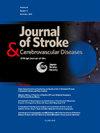血小板相关基因 IQGAP1 是缺血性中风患者发病和免疫异常的原因之一。
IF 2
4区 医学
Q3 NEUROSCIENCES
Journal of Stroke & Cerebrovascular Diseases
Pub Date : 2025-02-01
DOI:10.1016/j.jstrokecerebrovasdis.2024.108194
引用次数: 0
摘要
简介:缺血性脑卒中(IS)是一种复杂的疾病,由多种环境和遗传风险因素共同导致。最近的报道揭示了血小板在IS病理生理中的重要作用。在此,我们旨在探索IS中潜在的血小板相关基因,研究血小板相关基因在IS免疫微环境中的作用。方法:从Gene Expression Omnibus数据库中检索IS数据。首先,我们使用差异表达分析、富集分析和蛋白-蛋白相互作用(PPI)网络筛选与IS发病相关的血小板相关基因。此外,我们还分析了血小板相关基因在IS中的临床价值和功能信息。最后,我们探讨了血小板相关基因与免疫细胞浸润的关系。结果:鉴定出10个与IS发病相关的血小板相关基因,其中IQGAP1位于PPI网络的核心。IQGAP1在正常脑组织中表达,在IS脑组织中表达显著升高。在GSE16561和GSE58294数据集中,IQGAP1的曲线下面积(AUC)值都接近于1。IQGAP1敲低可能增加OGD/R诱导的HT22细胞活力。此外,IQGAP1高表达的IS患者FoxO信号通路、nod样受体信号通路、吞噬体和血小板激活途径均明显激活,而IQGAP1低表达的IS患者则明显激活。IQGAP1high组和IQGAP1low组IS患者免疫细胞比例和免疫相关功能存在显著差异,且IQGAP1表达与IS免疫细胞浸润相关。结论:在本研究中,我们发现IQGAP1可能作为IS的潜在诊断标志物,并且IQGAP1的表达与IS患者免疫细胞浸润有密切关系。本文章由计算机程序翻译,如有差异,请以英文原文为准。
Platelet related gene IQGAP1 contributes to the onset and abnormal immune landscape of ischemic stroke patients
Introduction
Ischemic stroke (IS) is a complex illness resulting from a combination of numerous environmental and genetic risk factors. Recent reports have shed light on the vital role that platelets play in the pathophysiology of IS. Here, we aimed to explore the potential platelet-related genes in IS and investigate the effect of platelet-related genes in the immune microenvironment of IS.
Methods
The data of IS were retrieved from the Gene Expression Omnibus database. Firstly, we screened the platelet-related genes that were correlated with the onset of IS using differential expression analysis, enrichment analyses, and protein-protein interaction (PPI) network. Moreover, we analyzed the clinical value and functional information of platelet-related genes in IS. Finally, we explored the correlation between platelet-related genes and immune cells’ infiltration.
Results
Ten platelet-related genes that were correlated with the onset of IS were identified, among which IQGAP1 was located at the core of the PPI network. IQGAP1 was found to be expressed in the normal brain tissue and its expression was significantly elevated in IS samples. The area under the curve (AUC) values for IQGAP1 in both the GSE16561 and GSE58294 datasets were close to 1. IQGAP1 knockdown might increase OGD/R‑induced HT22 cell viability. Additionally, FoxO signaling pathway, NOD-like receptor signaling pathway, Phagosome and Platelet activation pathways were significantly activated in IS patients with high IQGAP1 expression compared to those with low IQGAP1 expression. The IS patients in the IQGAP1high and IQGAP1low groups showed dramatically different proportions of immune cells and immune-related functions, and the IQGAP1 expression was correlated with the immune cell’ infiltration in IS.
Conclusions
In this study, we identified the IQGAP1 might serve as a potential diagnostic marker for IS, and the IQGAP1 expression was very relevant in determining the immune cell’ infiltration in IS patients.
求助全文
通过发布文献求助,成功后即可免费获取论文全文。
去求助
来源期刊

Journal of Stroke & Cerebrovascular Diseases
Medicine-Surgery
CiteScore
5.00
自引率
4.00%
发文量
583
审稿时长
62 days
期刊介绍:
The Journal of Stroke & Cerebrovascular Diseases publishes original papers on basic and clinical science related to the fields of stroke and cerebrovascular diseases. The Journal also features review articles, controversies, methods and technical notes, selected case reports and other original articles of special nature. Its editorial mission is to focus on prevention and repair of cerebrovascular disease. Clinical papers emphasize medical and surgical aspects of stroke, clinical trials and design, epidemiology, stroke care delivery systems and outcomes, imaging sciences and rehabilitation of stroke. The Journal will be of special interest to specialists involved in caring for patients with cerebrovascular disease, including neurologists, neurosurgeons and cardiologists.
 求助内容:
求助内容: 应助结果提醒方式:
应助结果提醒方式:


